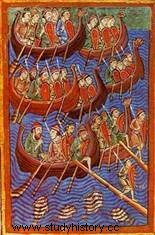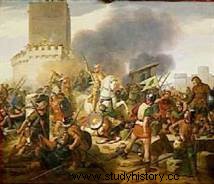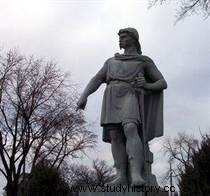 Between Franks and Vikings, relations were initially conflictual. The Carolingian Empire in full disintegration after the Treaty of Verdun (843) is not able to face the attacks of these warriors from the North. For several decades, the fight is fierce. It nevertheless led, in 911, to the creation of the Duchy of Normandy, ceded to the Viking Rollo by Charles the Simple. After having been among the most terrible adversaries of Francia, the Normans became an integral part of it.
Between Franks and Vikings, relations were initially conflictual. The Carolingian Empire in full disintegration after the Treaty of Verdun (843) is not able to face the attacks of these warriors from the North. For several decades, the fight is fierce. It nevertheless led, in 911, to the creation of the Duchy of Normandy, ceded to the Viking Rollo by Charles the Simple. After having been among the most terrible adversaries of Francia, the Normans became an integral part of it.
Who are the Normans?
Those commonly referred to as the Vikings were actually referred to by contemporary sources as the Normanni , the men of the North. If the term viking was known in the Middle Ages, it was popularized much later. Other sources mention the Danes , even the “pagans” or the “foreigners”. To the east are the Varangians. We will therefore use the term "Normans" here, especially since we will be mainly interested in the relationship of the latter with the Franks, initially conflicting relationships but which will end with the Treaty of Saint-Clair-sur-Epte.
All these peoples come from Scandinavia, and experience internal transformations at the end of the 8th century, which push them in a movement of expansion towards the South. The problem is that historians have long ignored almost all the details of these mutations. Today, we talk about the desire of Scandinavian kings to assert their authority over local chiefs, provoking competition and exile. To this must be added the development of trade and a growing appetite for wealth. In no way, they are in any case barbarians who loot for the pleasure of looting, contrary to the image that they have dragged for a long time. England and the nearby Carolingian Empire are the first to attract their covetousness, having probably been trading partners.
The Carolingian Empire is falling apart
The death of Louis the Pious, son of Charlemagne, in 840 confirms the serious problems experienced by the Carolingian Empire from the 820s. A civil war breaks out between the three sons of Louis the Pious and, in 841, Charles the Bald and Louis the German are victorious over their brother Lothair. A year later, they signed the oath of Strasbourg, swearing mutual assistance, isolating Lothair, who had to accept the Treaty of Verdun in 843:the Empire was divided into three kingdoms, including Western Francia. The dissensions are not finished for all that, and the old empire of Charlemagne is ready to suffer under the blows of the Normans.
 The first Norman raids in Francia
The first Norman raids in Francia
Nevertheless, it was under Louis the Pious, and even as early as Charlemagne, that the Franks began to get to know the Normans. First in the form of small-scale raids, carried out mainly by Danes. Their original but formidable boats allow the Normans to coast and go up the rivers very easily, and to be elusive. In 799, a hundred Normans were killed by the local defense near Noirmoutier. Then, in 820, they attacked Flanders and the mouth of the Seine before attacking Vendée again in the 830s. Francia, however, was less affected at this time than the British Isles and Ireland. .
The 840s seem like a turning point. Attacks are conducted by many more ships and combatants, and against multiple targets, simultaneously. In addition, the Normans are no longer content to loot and leave, they stay longer in place, penetrate further inland. We see them for example wintering in the lower valley of the Seine in the early 850s.
Several large cities or their surroundings were affected by these raids:Nantes (843), Toulouse (844), Paris (845),… In 848, they besieged Bordeaux. The Loire and Seine valleys are constantly under threat from Norman looters. The powers then begin to try to buy peace, by paying tribute, and even to propose to the Normans to engage as mercenaries in the civil wars which strike the old empire.
The height of the Norman raids and the siege of Paris
 Between 856 and 862, the raids are even more urgent. Settled on the island of Oissel, the Vikings attacked Saint-Denis, and took Abbé Louis, cousin of the king and grandson of Charlemagne, prisoner! Charles the Bald must pay a huge ransom, which further weakens him in an already difficult context for him. The policy of tributes continued until the end of the 9th century, to contain the Norman raids, without much success, apart from the lifting of the siege of Angers in 873.
Between 856 and 862, the raids are even more urgent. Settled on the island of Oissel, the Vikings attacked Saint-Denis, and took Abbé Louis, cousin of the king and grandson of Charlemagne, prisoner! Charles the Bald must pay a huge ransom, which further weakens him in an already difficult context for him. The policy of tributes continued until the end of the 9th century, to contain the Norman raids, without much success, apart from the lifting of the siege of Angers in 873.
Indeed, the death of Louis le Bègue, son of Charles, in 879, created a new major crisis within the former empire of Charlemagne. The Normans are now well anchored in Basse-Seine, and they lay siege to Paris in 885. The city resists somehow for a year, defended by Eudes. It takes the arrival of Charles the Fat for an agreement to be reached and the city finally liberated in 887, again for tribute. The Normans return quietly to the Scheldt valley.
The creation of the Duchy of Normandy
A year after the end of the siege of Paris, its defender Eudes becomes king of West Francia, opening the Robertian dynasty. He continued to fight the Normans, over whom he won a few victories, ridding the Seine valley of their presence in 889. But he ultimately preferred to do as his predecessors did and pay them tribute. He was a disputed king anyway, until his death in 898. As for the Normans, for the most part, they decided to concentrate on England.
 Eude's successor, Charles the Simple, was crowned as early as 893 by the enemies of the Frankish king in place . On his actual arrival on the throne, he must in turn face the Norman raids. In 911, Charles liberated Chartres from the Norman threat and, in a position of strength, decided to negotiate with one of their leaders, a certain Rollo. The Treaty of Saint-Clair-sur-Epte was signed in the fall of 911:the Normans could remain in a strictly delimited region, but must assist the Frankish king, and convert to Christianity. The treaty confirms a movement of rapprochement between Normans and Frankish powers and a desire for integration that began in the 850s, despite the looting.
Eude's successor, Charles the Simple, was crowned as early as 893 by the enemies of the Frankish king in place . On his actual arrival on the throne, he must in turn face the Norman raids. In 911, Charles liberated Chartres from the Norman threat and, in a position of strength, decided to negotiate with one of their leaders, a certain Rollo. The Treaty of Saint-Clair-sur-Epte was signed in the fall of 911:the Normans could remain in a strictly delimited region, but must assist the Frankish king, and convert to Christianity. The treaty confirms a movement of rapprochement between Normans and Frankish powers and a desire for integration that began in the 850s, despite the looting.
Those who did not settle in Normandy (Danes and Norwegians) concentrated their efforts on the British Isles, while the Swedes took the road to the East. The Franks, they will integrate their Normans to make it one of the most important and powerful elements of the kingdom of France in the following centuries. Better still, from England to the Mediterranean, the adventure of the Normans had only just begun...
Bibliography
- F. Neveux, The Norman Adventure , Perrin, 2006.
- Y. Cohat, The Vikings, Kings of the Seas , Gallimard, 1987.
- G. Bührer-Thierry, C. Mériaux, La France before France (481-888), Belin, 2011.
- J. Haywood, Viking Atlas (789-1100) , Otherwise, 1996.
- C. Gauvard, France in the Middle Ages from the 5th to the 15th century , PUF, 2005.
- The Normans:from Normandy to the Kingdom of Sicily , Ancient &Medieval History, no28H, August 2011.
To go further
- P. Bauduin, The Frankish world and the Vikings (8th-10th centuries) , Albin Michel, 2009.
